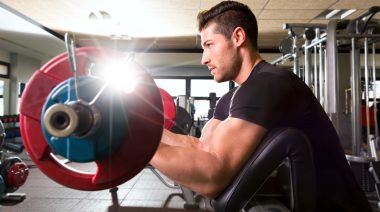The classic sit-up is one of the first exercises most people learn to perform. Sometimes on their own at home as an early attempt to get into better shape or in school during gym class where it was less painful than dodgeball and more fun than square dancing.
The sit-up remains a time-tested fitness evaluation and is an extremely simple and effective way to develop core strength. It’s also developed a debatable reputation for being “bad for your back”. Let’s learn how to perform it, safely and correctly for better abs, more strength, and less pain.
- How to Do the Sit-Up
- Sit-Up Mistakes to Avoid
- Benefits of the Sit-Up
- Muscles Worked by the Sit-Up
- Who Should Do the Sit-Up
- How to Program the Sit-Up
- Sit-Up Variations
- Sit-Up Alternatives
- Frequently Asked Questions
How to Do the Sit-Up
All you need to perform the sit-up is your body and a chunk of floor space. As simple as the exercise may appear, there are a few technique tips to make sure you’re getting results most efficiently.
Step 1 — Lie Down
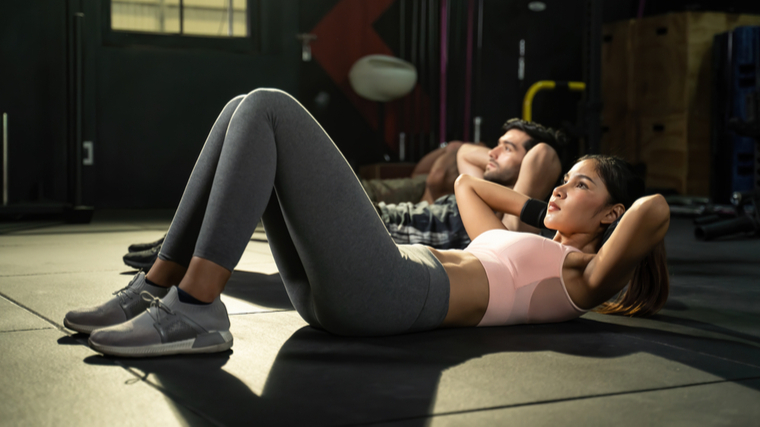
Begin lying on the floor facing up. Your feet should be flat on the ground with your knees bent. Move your feet slightly forward, away from your glutes, and set them hip-width apart. Having your feet too close to your body, or too close together, reduces leverage and makes it difficult to achieve a full range of motion.
Some lifters choose to have the feet held down in place, either by a partner or an immovable object. This should be avoided because it can decrease abdominal focus, recruit alternative muscles (like the hip flexors), and may encourage poor technique.
As opposed to the classic “hands clasped together behind your head” position, keep your fingertips on either side of your head gently touching your ears or temples. This prevents you from pulling on your head and straining your neck. The back of your head and shoulders should be touching the ground before the first rep begins.
Form Tip: To make the exercise less challenging, begin the set with your torso sitting up, not lying on the ground. This helps to work the “stretch-shortening cycle”, which improves a muscle’s strength immediately following a stretched position. (1) Be sure to lower yourself under control without “bouncing” your body off the floor.
Step 2 — Sit Up
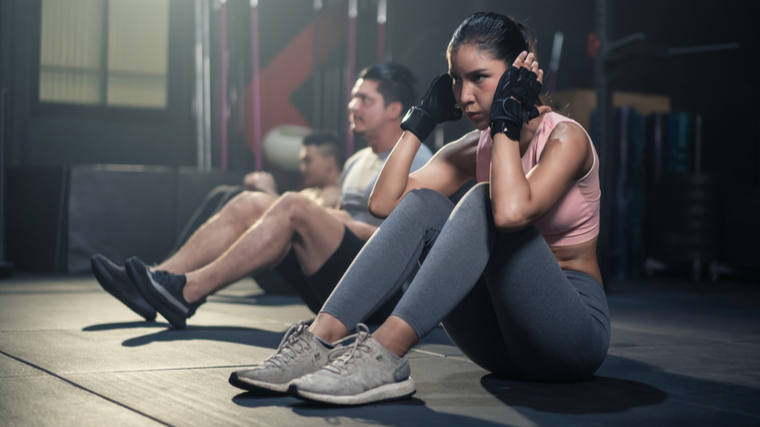
Keep your fingertips in contact with your ears and your feet in contact with the ground. Bring your torso towards your knees by contracting your abdominal muscles. Your head and neck should remain neutral, not pointed up or down, as you move. You should feel muscular tension throughout your entire upper body, particularly in your abs.
To maximally activate your ab muscles, your upper body should curl and “crunch” as you rise up, rather than keeping a straight line from your shoulders to your hips. In the top position, your upper body should be close to your knees and thighs.
Form Tip: If you feel lower back strain during a set, move your feet slightly farther from your body and slightly wider apart. Be sure to start the movement by flexing your torso and “crunching” your abs. Keeping your torso straight de-emphasizes ab muscle recruitment and shifts the muscular stress to the hip flexors, which can worsen back pain.
Step 3 — Lower to the Ground
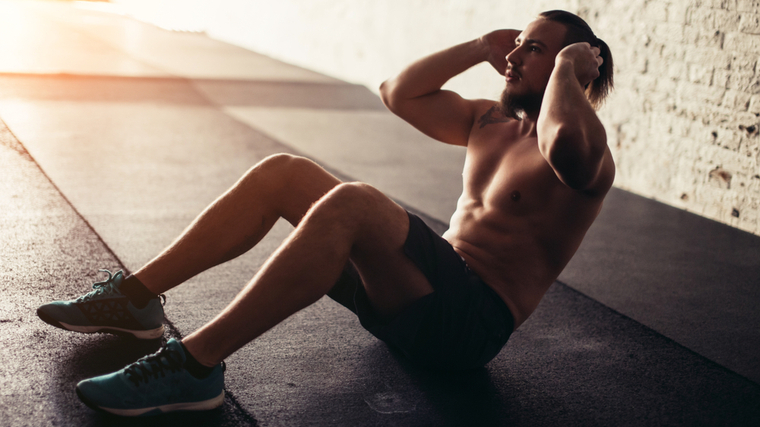
Begin the descent by reversing direction and “un-curling” your upper body while lowering yourself to the ground. Resist the urge to rebound immediately off the floor, which increases injury risk and decreases muscle involvement. Quickly reset before transitioning smoothly into the next repetition.
Form Tip: In the bottom position, take a deep breath into your belly, not your chest (also known as diaphragmatic breathing). Beginning a rep with this deep breath and steadily releasing it while sitting up can help to increase muscular stress and power output.
Sit-Up Mistakes to Avoid
Many lifters underestimate seemingly simple bodyweight exercises like the sit-up and, as a result, end up performing them incorrectly which lessens any potential results and reduces the overall effectiveness. Here are the most common training mistakes to avoid.
Pulling Your Head Forward
Your torso should be moving up and down during each rep. Your chin shouldn’t be. One big reason for avoiding the popular hands-behind-your-head position is that, deliberately or accidentally, it can encourage you to pull your head with your hands as if you were lifting your entire body with your skull as a handle.
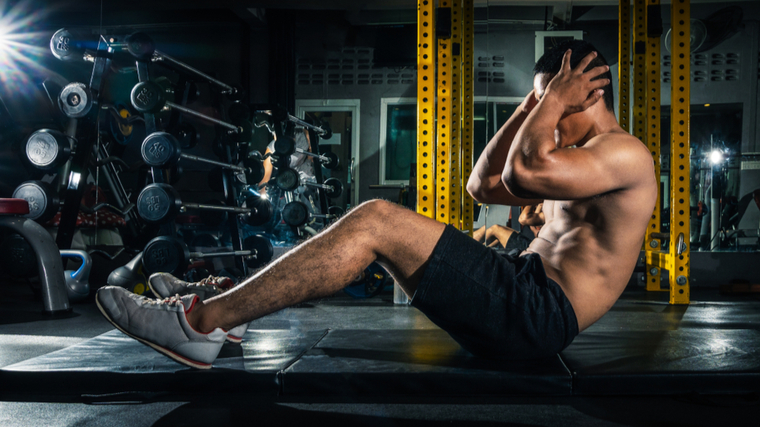
Not only does this not actually help anything, but it can put significant strain on the small muscles of your cervical spine and overall neck. If you feel any increasing strain on your neck during a rep, you’re likely pulling with your hands instead of flexing your abdominals.
Avoid It: Don’t put your hands in a position to help in the first place. Keep your fingertips touching, or nearly touching, your ears so they’re not in a position to pull on anything. Alternatively, you could cross your arms in front of your chest or clasp your hands in front of your chin. Both options remove the urge and ability to pull your body up.
Using Momentum, Not Muscle
Many lifters consider the sit-up to be ideal for performing high-rep sets, which it can be. However, some fall into the trap of using any method necessary to complete extra repetitions. The “easiest” way is to begin using momentum, not muscular force, to get moving.
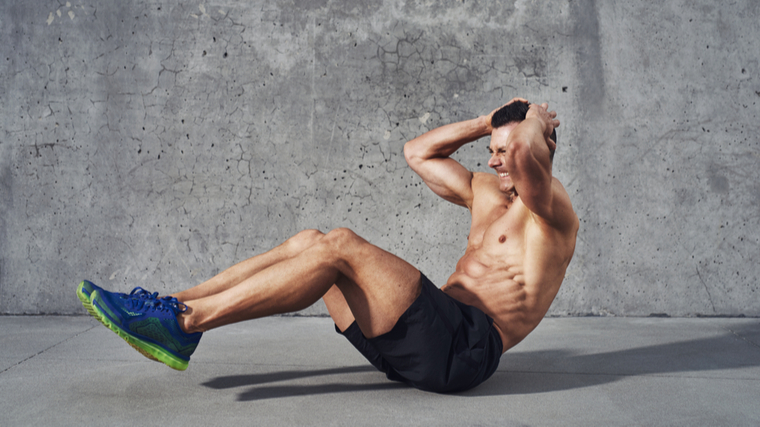
By swinging the arms as if throwing an imaginary beach ball, kicking the legs, or incorporating hip movement by raising and lowering the glutes off the floor, it’s possible to “swing” the torso up to the finished position. This not only reduces muscle activation in the abs but also increases strain on the joints of the hips and lower back.
Avoid it: Very simply, don’t exchange technique for extra reps. Maintain a controlled crunch of the torso going upwards. Keep your glutes touching the floor throughout the entire set. Keep your fingers touching near your ears.
Benefits of the Sit-Up
For years, sit-ups were the quintessential “workout exercise.” Gotta get in shape? Start with sit-ups. Gotta get stronger? Do your sit-ups. Wanna lose weight? Sit-ups will burn that fat fight off.
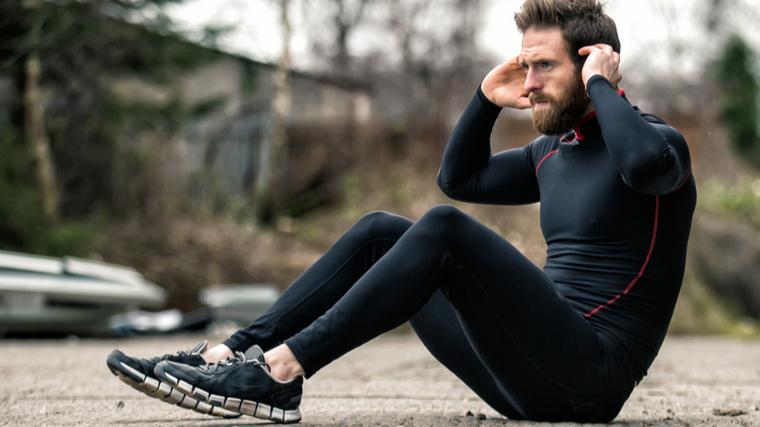
Some of these were on the right track, others were a bit misguided. Here’s what the exercise really offers.
Core Strength
The sit-up is an extremely effective exercise for building total core strength. The abdominal muscles are worked through a significant range of motion while the lower back, glutes, and even the hamstrings are recruited as stabilizing muscles.
Ab Muscle Development
Training the abs is, unsurprisingly, a really effective way to build abs that look great. While a variety of ab exercises like crunch variations and twists can also be effective, the standard sit-up remains among a popular and effective choice for activating the ab muscles.
Muscles Worked by the Sit-Up
The sit-up may be one of the most well-known ab exercises. Its straightforward performance, long history, and wide-spread popularity have helped to cement it as one of the few exercises many lifters and non-lifters are familiar with. Here’s a deeper look at the muscles involved.
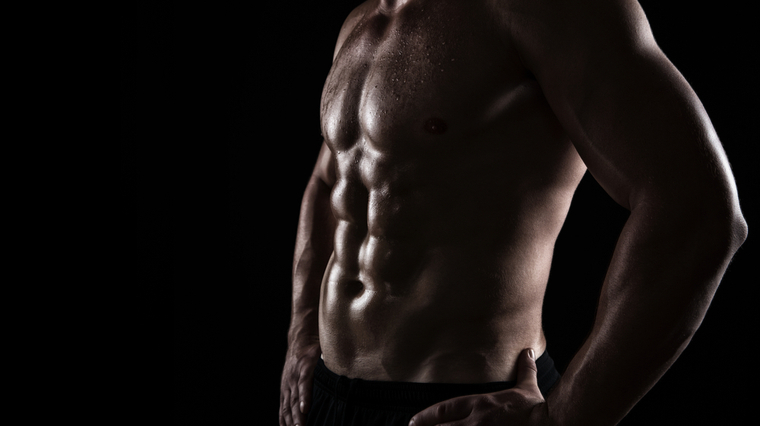
Rectus Abdominis
This is the main ab muscle running down the front of the torso which makes up the “six-pack” and it’s the primary muscle people are referring to when they talk about the abs.
It’s responsible for flexing the torso in a curling motion to bring your sternum (mid-chest) closer to your hips. This is why keeping your torso straight as you rise up decreases the abs’ ability to contract.
The rectus abdominis is sometimes referred to separately as the “upper abs” above the belly button near the lower chest and “lower abs” below the belly button near the belt-line. While it is one single muscle, research shows that two separate sections can be activated to varying degrees by certain exercises. (2)
Ab exercises with torso movement, like the sit-up, typically emphasize the upper abs while ab exercises with leg movement, like the hanging knee raise, emphasize the lower abs.
Hip Flexors
The hip flexors are a collection of several small muscles found near the top of each thigh connecting to the pelvis and lumbar spine (lower back). They serve to bring the upper leg closer to the chest, in a movement similar to bending at the waist.
The hip flexors are recruited during sit-ups, more so when the torso is kept straight or when the feet are weighted down and held in place during the movement. (3)
Because the hip flexors connect to the lumbar spine, they are heavily associated with contributing to, or relieving, back pain depending on the muscles’ strength, flexibility, and mobility. (4)
Who Should Do the Sit-Up
The sit-up remains a fundamental movement for building core strength and abdominal muscle. It can be incorporated into almost any type of training plan.
Training for Strength
Core strength and endurance have been shown to help improve strength and athletic performance. (5)(6) For this reason, sit-ups can play a key role in any training program designed to build total-body strength or power.
Training for Muscle
All muscles of the body can be stimulated for muscle growth, including the abdominals. The sit-ups are a simple and effective exercise for targeting the abs.
Some lifters mistakenly believe direct ab training may create a “blocky” or bulky-looking waistline, but this isn’t a valid concern because that appearance has more to do with excess body fat than muscle growth.
Similarly, some lifters avoid any direct ab exercise, believing that ab definition is simply the byproduct of a general fat loss plan combined with basic compound exercises. But getting good-looking abs requires some direct work, not just reduced calories, running, and squatting more.
Training for Performance
The sit-up is a popular fitness assessment with some law enforcement and military organizations, often tested for maximum reps in a set timeframe. For this reason, training the sit-up would be considered “sport-specific,” since the most direct way to improve performance is to practice the exercise itself.
How to Program the Sit-Up
The sit-up can be programmed in a number of different ways to accommodate the specific training goal. As with many bodyweight exercises, adding external load such as a weighted vest, weight plate, or dumbbell can increase resistance and allow more programming options.
Unweighted, Moderate to High Rep
Performing the sit-up with your own bodyweight for two to three sets of 10 to 20 reps with 30 seconds rest between sets can be a quick and effective addition to any training program. This approach could even be incorporated into a general warm-up, rather than a workout, for experienced lifters.
Light Weight, Moderate Rep
Add external resistance and perform three to four sets of six to 12 reps with one minute between sets. This would be an intense workout to build core strength. Exercise technique with and without weight should be identical. Adding weight should not compromise form.
For Time
As one part of a physical fitness test, typically in law enforcement or military organizations, sit-ups are required to be performed for maximum reps in one to two minutes. The key with this training approach is to maintain proper technique for the duration and not allow form to get sloppy in order to rush through low-quality reps.
Sit-Up Variations
Because the sit-up is a relatively straightforward exercise (literally and figuratively), simple adjustments to the basic movement can recruit or emphasize different muscles for a more diverse stimulus.
Twisting Sit-Up
Sometimes called knee-to-elbow sit-ups, incorporating a twisting motion recruits the oblique muscles running along either side of the rectus abdominis.
Rather than ending with your chest directly in front of your thighs and knees, end each repetition with your chest pointed toward one knee. Alternating sides on each rep is common, but reps may be performed all to one side followed by the same reps to the opposite side.
Janda Sit-Up
Created and popularized by physiotherapist Dr. Vladimir Janda, the Janda sit-up activates the hamstrings to deactivate the hip flexors. The result is a significantly increased abdominal contraction.
This works by a neurological and physical mechanism technically known as “reciprocal inhibition.” Essentially, it’s a phenomenon which prevents muscles on one side of the body from contracting if the muscles directly opposing it are already intensely contracting.
Straight-Leg Sit-Up
The straight-leg sit-up, like it sounds, is performed with your legs straight and heels on the ground instead of with your legs bent and feet flat on the ground.
This adjustment increases the overall range of motion and significantly increases recruitment of the hip flexors. The straight-leg sit-up is very similar to the Pilates exercise known as a “roll-up.”
Two-Arm Overhead Sit-Up
Keeping both arms raised perpendicular to the ground, rather than close to the body, alters leverage and significantly increases the difficulty. This variation is performed by keeping both arms straight and pointed towards the ceiling throughout the rep.
As an even more advanced variation, you can hold a light dumbbell in each hand or one weight plate with both hands. This will also increase shoulder recruitment, specifically in the smaller stabilizer muscles of the shoulder and upper back.
Sit-Up Alternatives
Some lifters are unable to perform sit-ups, typically because of pre-existing back problems or general difficulty achieving a full range of more. These are some of the most effective options.
Crunch
The crunch may have been the one exercise to bump the sit-up from its prominent spot as the go-to ab exercise. It’s been shown to be one of the most effective ways to specifically target the abs. (7)
The crunch does have a significantly shorter range of motion compared to the sit-up, but that’s one reason why it’s an effective ab exercise. The movement is deliberately restricted to avoid involvement of other muscle groups.
Hanging Knee Raise
Using either a pull-up bar or specialized knee raise station (sometimes called a captain’s chair or Roman chair), the hanging knee raise emphasizes the lower abs. Be sure to curl the entire hip region upwards, rather than only moving the legs, to recruit more ab muscles.
The hanging position also helps to “decompress” the spine by allowing a stretch and relieving tension. This exercise can be made more challenging by using straight legs or eventually progressing to the “toes to bar” position with a full range of motion.
V-Up
The v-up, sometimes called a jackknife sit-up, is a high-intensity total-body core exercise involving the ab muscles while incorporating the arms and legs together. By raising your legs while reaching upwards with your arms, significant stress is placed on the lower abs as well as the upper abs.
This is one of the most challenging bodyweight ab exercise alternatives because it requires high levels of strength, coordination, and mobility.
FAQs
Will doing sit-ups specifically burn belly fat?
Fat, regardless of where it’s stored on the body, is most efficiently burned with a specialized nutrition plan (including a calorie deficit) coordinated with an intense training program. Performing sit-ups and other ab exercises does not lead to any drastic “spot reduction” by significantly increasing abdominal fat loss. (8)
Several decades of research have investigated this persistent idea, as well as countless hopeful lifters over the same time period, and the results have been inconclusive at-best. Any results showing spot reduction to work have been measured in millimeters, not inches.
Time and effort are much better spent on a comprehensive fat loss plan rather than over-relying on spot reducing the abs.
Why does my back hurt during and after a set?
Lower back pain is the most common reason for avoiding sit-ups. This may be due to the hip flexors involvement during the exercise, which stresses the lumbar spine, or the pain may be due to the flexion (crunching) motion aggravating lower back strain. (9)
Modifying sit-up technique by widening the foot stance and shortening the range of motion may help. If pain persists, removing sit-ups from the workout program and incorporating an alternative may be the most effective solution.
References
- Seiberl W, Hahn D, Power GA, Fletcher JR, Siebert T. Editorial: The Stretch-Shortening Cycle of Active Muscle and Muscle-Tendon Complex: What, Why and How It Increases Muscle Performance?. Front Physiol. 2021;12:693141. Published 2021 May 20. doi:10.3389/fphys.2021.693141
- Duncan M. (2009). Muscle activity of the upper and lower rectus abdominis during exercises performed on and off a Swiss ball. Journal of bodywork and movement therapies, 13(4), 364–367. https://doi.org/10.1016/j.jbmt.2008.11.008
- Burden, A. M., & Redmond, C. G. (2013). Abdominal and hip flexor muscle activity during 2 minutes of sit-ups and curl-ups. Journal of strength and conditioning research, 27(8), 2119–2128. https://doi.org/10.1519/JSC.0b013e318278f0ac
- Avrahami D, Potvin JR. The clinical and biomechanical effects of fascial-muscular lengthening therapy on tight hip flexor patients with and without low back pain. J Can Chiropr Assoc. 2014 Dec;58(4):444-55. PMID: 25550670; PMCID: PMC4262809.
- Kocahan T, Akınoğlu B. Determination of the relationship between core endurance and isokinetic muscle strength of elite athletes. J Exerc Rehabil. 2018;14(3):413-418. Published 2018 Jun 30. doi:10.12965/jer.1836148.074
- Shinkle, J., Nesser, T. W., Demchak, T. J., & McMannus, D. M. (2012). Effect of core strength on the measure of power in the extremities. Journal of strength and conditioning research, 26(2), 373–380. https://doi.org/10.1519/JSC.0b013e31822600e5
- Escamilla RF, Lewis C, Pecson A, Imamura R, Andrews JR. Muscle Activation Among Supine, Prone, and Side Position Exercises With and Without a Swiss Ball. Sports Health. 2016;8(4):372-379. doi:10.1177/1941738116653931
- Paoli A, Casolo A, Saoncella M, et al. Effect of an Endurance and Strength Mixed Circuit Training on Regional Fat Thickness: The Quest for the “Spot Reduction”. Int J Environ Res Public Health. 2021;18(7):3845. Published 2021 Apr 6. doi:10.3390/ijerph18073845
- Sutanto, D., Ho, R., Poon, E., Yang, Y., & Wong, S. (2022). Effects of Different Trunk Training Methods for Chronic Low Back Pain: A Meta-Analysis. International journal of environmental research and public health, 19(5), 2863. https://doi.org/10.3390/ijerph19052863
Featured Image: UfaBizPhoto / Shutterstock



